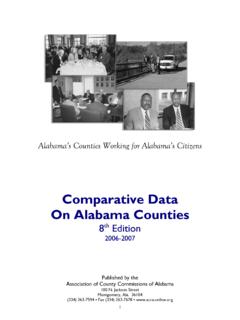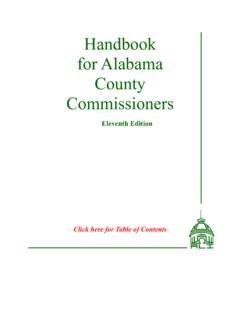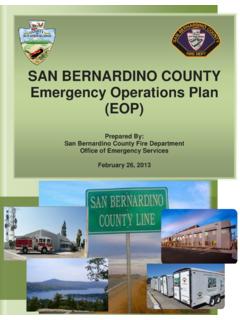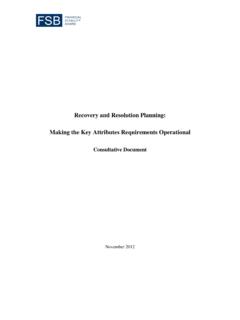Transcription of Cullman County Elected Officials Guide to Emergency …
1 Cullman County Elected Officials Guide to Emergency Management 2 TABLE OF CONTENTS What is Emergency History of Emergency Management in About Cullman Role of Elected Officials : In Leadership Before a During Standing Requesting Assistance & Emergency Management Incident Tracking Disaster Response & Declaration FEMA Damage Expense Threshold Local Process to Request a Disaster Declaration Process (diagram)..14 Types of Emergency Declarations ..15 In Preliminary Damage Types of Federal Disaster Individual Public In Do s & Don Attachments: Cullman County resolution , February 27, Why an EOC and What should it do?
2 23 EOC Activation Levels ..23 Summary of Emergency Proclamations & Declarations Local State of Declaration of Emergency Conditions Declaration of Emergency Declaration of Emergency Declaration of Emergency Conditions/Joint County & Termination of Emergency Glossary of Emergency Management Alabama Emergency Management Act of Types of Federal Disaster Cullman Co EMA Contact Ten Steps of Crisis 3 Cullman County Elected Officials Guide TO Emergency MANAGEMENT What is Emergency Management? Emergency Management is a network of government partners (local, state, and federal) working together with local volunteers, business, and others to mitigate, prepare for, respond to, and recover from all hazards affecting a community.
3 Cullman County EMA is the local agency responsible for coordination of mitigation, preparedness , response, and recovery efforts to protect lives and property of the residents within the geographical boundaries of Cullman County . Natural hazards affecting Cullman County include tornadoes, severe thunderstorms, lightning, flash flooding, winter storms, and wildfires. These events are both dangerous and unpredictable. Therefore it is important that you know what actions Emergency Management is taking before, during, and after an Emergency . In addition, there are other manmade and technological hazards that pose an equal, if not greater threat to local citizens. These hazards require specific planning and programs. These plans and programs have been developed to respond to both natural and manmade events: -Local Emergency Planning Committee (LEPC) serves as the repository for information regarding hazardous materials utilized by local industry and also serves as the all-hazards planning group for Cullman County - Cullman County All-Hazards Emergency Operations Plan provides an overall Guide for response to threats and hazards that affect Cullman County .
4 In addition to the overall plan, each jurisdiction, agency, department, and volunteer response agency develops a specific Standard Operations Plan (SOP) for their particular discipline that is coordinated with the overall plan. - Cullman County Natural Hazards Mitigation Plan provides a Guide for all local jurisdictions and qualified applicants to plan a mitigation strategy to reduce the threat and damage to persons and property. All mitigation projects listed are specific to the jurisdictions of Cullman County This Guide is an informational summary of Cullman County Elected Officials responsibilities before, during, and after an Emergency or disaster. 4 -Debris Management Plans provides priorities and guidelines for the County response to debris removal and management. Priorities include lists of the primary and secondary roadways to be kept open to provide access to critical facilities. -Staging and Distribution Plans provides a Guide for the staging and distribution of commodities and supplies that may be needed following a catastrophic event in Cullman County .
5 This plan includes the identification of potential sites for the staging and/or distribution of supplies across Cullman County . -Strategic National Stockpile Plan (SNS) provides a Guide for the distribution of pharmaceuticals that may be needed for events that pose a severe threat to the health of residents. -Mass Fatality Management Plans provides a Guide for the local response to an event that result in the deaths of a large number of victims. This plan is activated upon request by the Cullman County Coroner when the number of victims overwhelms the capacity of local resources. -Continuity of Government & Continuity of Operations Plans provides a Guide for the continuing operations of critical government operations. -Superfund and Reauthorization Act (SARA) Title III - Emergency Planning & Community Right-to-Know Act (EPCRA) - provides information regarding hazardous materials releases to the public. -Public Education Programs Severe Weather Awareness & Storm Spotter Class, Citizens Emergency Response Team (CERT) and - Homeland Security History of Emergency Management in Alabama The roots of Emergency management in Alabama go all the way back to World War I when Civil Defense Councils were developed in each state to encourage public support for the war effort.
6 This consisted mainly of pushes to buy War Bonds. During WWII, the State of Alabama trained citizens to be air raid wardens, ambulance drivers, auxiliary police and enemy aircraft spotters. When the atomic warfare era was ushered in at the war s conclusion; the emphasis shifted the Civil Defense program to public preparedness for a possible nuclear attack. By 1978, the realization that citizens faced recurring threats from natural and technological hazards prompted local, state, and federal governments to revamp the program and establish the Emergency Management Agency. 5 Alabama s civil preparedness actions mirror those of the national government. The Alabama Department of Civil Defense was established by Section 4, Alabama Law 1955, Act No. 47, to administer the Emergency preparedness program for the State. The act was amended in 1978; Acts 1978, No. 852, to provide for the administration of grants to political subdivisions of the state; and on July 25, 1983, the act was amended again to rename the Department of Civil Defense as the Alabama Emergency Management Agency (AEMA).
7 Following in the footsteps of the State, the Cullman County Commission established the Cullman County Emergency Management Agency by resolution on February 27, 1984. Cullman County EMA is an all-hazards agency working and planning to mitigate, prepare for, respond to, and recover from natural, technological, and manmade threats in Cullman County . Each County in Alabama is required by federal and state law to maintain a viable Emergency management program due to the variety of natural, manmade and technological threats faced by the public and our fiscal and physical infrastructure. The Emergency management program is not intended to undermine the authority and duties of the incident commander in the field or the local government agency or department heads. The Emergency management agency is central to coordination of prevention, preparedness , response, and recovery activities. Prior to an event, during routine business days, the CCEMA director and staff will spend countless hours writing and reviewing plans and procedures, conducting and attending training, coordinating exercises, establishing working relationships with partner agencies and organizations, briefing Elected Officials , conducting public awareness campaigns and developing relationships with the media and other EMA directors in surrounding counties.
8 During an event, EMA activates the Emergency Operations Center (EOC) to serve as the center of, plan implementation, assessment of needs, decision making and assignment of available resources to the impacted area. The CCEMA staff provides overall incident situational awareness for Elected Officials , government departments and agencies, non-governmental agencies and Emergency operations. CCEMA serves as the primary conduit to keep the public informed during an event. Events not requiring outside assistance are managed from the EOC and utilize local resources, County and municipal. Larger events requiring assistance, but not reaching the level of a State or Federal Emergency are handled by requesting County -to- County assistance through the North Alabama Mutual Assistance Association. As available resources are exhausted the request for assistance moves statewide and requests are made through the Alabama Emergency Management Agency (AEMA).
9 Cullman County EMA is the avenue for requests of state and federal resources as well as the conduit for requesting an Emergency declaration. It is the key that opens the door to reimbursements once a Presidential disaster is declared. Obtaining and keeping public and Elected official support is critical to maintaining an effective Emergency management program. Therefore it is important that Elected Officials maintain contact with EMA staff between events, and take a high-profile lead in Emergency planning and preparedness . 6 Local EMA shoulders the bulk of Emergency response. Only two percent (2%) of all disasters in the United States receive a Presidential Disaster Declaration and just 12% receive a State declaration. In the absence of a Presidential Disaster Declaration, State and local governments must absorb the cost of disasters. In the absence of a State Disaster Declaration, local government must absorb the entire cost of disaster response.
10 The Alabama State Legislature created the Alabama Disaster Fund to assist communities affected by disaster but not eligible for a Presidential Disaster Declaration. The fund is overseen by a board of state and local Emergency management professionals; the fund, established in 2009 (Sec. 31-9-81; (Act 2009-342, p. 661, 2.) remains unfunded. The goals of Emergency Management are: Life Safety Incident Stabilization Protection of Property & the Environment About Cullman County EMA Established by County resolution on February 27, 1984 Located at 2020 Beech Ave SE Cullman (basement of Cullman Co Water Dept Bldg) Mailing Box 924 Cullman AL 35056-0924 Phone 256-739-5410 Fax 256-737-0876 All-Hazards, Multi-Jurisdictional Planning Agency Coordinating agency for Cullman County Disaster preparedness , Mitigation, Response, and recovery activities Maintains and activates Cullman Co Outdoor Warning Sirens Point of Contact and Records Repository for Local Emergency Planning Committee (LEPC) Local Point of Contact for Alabama Homeland Security Member of the North Alabama Mutual Assistance Association Coordinating agency for the Alabama State Mortuary Operations Team (SMORT))













